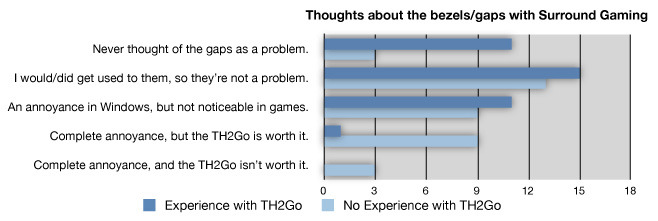Matrox TripleHead2Go Digital Edition Review - Improvements in the Digital Edition
Cable Management
While this feature may only be considered a minor update to some, anything that helps to tame the tangle of cables is always welcome here. The original TH2Go had two monitor outputs on one side of the box, and both an input and output on the other side. This caused the cable from the "orphan" output to be bent back around the unit in a 180 degree fashion, creating more cable management issues. With the DTH2Go, the input and USB cable are on one side of the unit, and the three outputs are on the opposite side. This allows for a better input/output cable flow, and helps reduce cable clutter.
Digital Connections
The major update to the DTH2Go is the use of digital connections. This improvement allows the video signal to remain in a pure digital form from your video card to the panel. The native resolution of my monitors is 1280x1024 - a 5:4 ratio. The full resolution of the setup is 3840x1024 - a 15:4 ratio. The DTH2Go also supports 3x4:3 resolutions such as 3072x768 (3x1024x768) - which is a 16:4 ratio. My LP1965s actually perform "Aspect Scaling" on the 16:4 ratios (with a slight letterbox), rather than stretch the 16:4 image to fill the 15:4 ratio of the panels.
While some people may not like the idea of letterboxing the image, I greatly prefer it to the idea of a stretched image. I contacted Matrox and confirmed that the DTH2Go does not scale the image itself. It is the digital signal that makes this a possibility.
Bezel Management
By and large, the vast majority of users who have experience with a TH2Go don't perceive the monitor bezels as a problem. The WSGF has a running poll in the Surround Gaming forum, with the results as below (as of the posting of this review):

While you can always disassemble your monitors to reduce the width of the bezel, until the Seamless Display hits mass-market, you need a solution for dealing with how the on-screen image transitions across the bezels.
Matrox has provided a fix with Bezel Management in the DTH2Go. Bezel Management allows the DTH2Go to "remove" columns of pixels at the point the monitors meet. This allows objects on the screen to "pass behind" the bezels, rather than "jump across" them. This fix is a major improvement to the image quality and integrity, and goes a long way in helping with the players "immersion," as games look more natural.
Adjusting the Bezel Management will give black bars down the outside of your image. I contacted Matrox regarding the issue, and they informed me this was normal behavior. The DTH2Go is pulling the data out of the image, and is unable to add back extra data to the edges due to limitations with the frame buffer. The image in the frame buffer is not actually effected in the graphics card, as screenshots and movies from FRAPS don't have any distortion or gaps. While noticeable if you turn your head to look at the edges, I don't find the black bars to be an issue. Bezel Management can be turned off and on as you prefer.
Bezel Management is handled through the Matrox PowerDesk utility.
The USB Advantage
The original TH2Go used a "wall wart" AC adapter to supply power to the unit. This has been updated in the DTH2Go and the unit now receives its power through a USB cable connected to your PC. This change provides a noticeable benefit to cable management and ease of installation. "Wall warts" are a nuisance and often take up valuable space on a power strip, where space is often a premium. If more outlets are eventually needed, the only feasible option is to add another power strip to the second all outlet, or daisy-chain a new outlet to the first.
USB ports, on the other hand, are often in large supply. And, when they are scarce, additional ports are easy added with a USB hub. The USB port also provides a significant improvement in the original unit in the areas of firmware upgrades. During the lifecycle of the original TH2Go, Matrox released a firmware upgrade that offered support for three widescreen displays running at either 1280x720 or 1280x768. The only way to get the firmware was to purchase a unit after the firmware was released, or send your unit in for updating. Obviously, neither of these are optimal solutions. With the DTH2Go, firmware updates can be applied by the user, with the update utilizing the USB connection to flash the DTH2Go.
Early in the life-cyle of the DTH2Go, Matrox issued a firmware update to address user complaints over the "main" screen being the left-hand screen. This means when playing a game in a "normal" resolution of 1280x1024 (or similar), the unit would display the game on the left screen, rather than the center. Matrox was able to quickly develop a patch that made the center display the "primary" display, and allow users to perform their own updates. This ability allows for greater customer satisfaction and lower support costs for Matrox, as users no longer have to send units in for updates.
